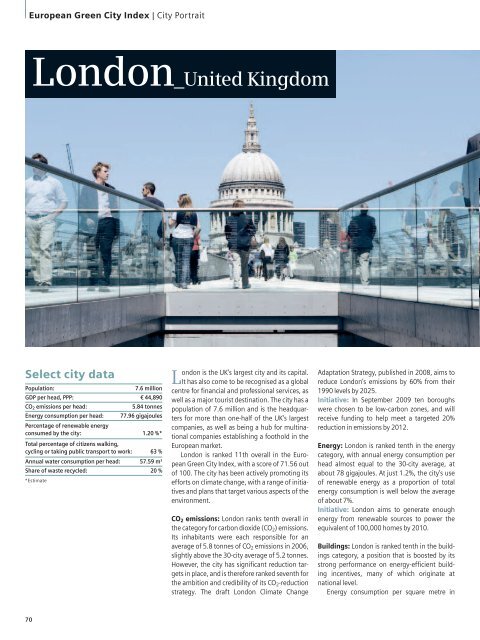European Green City Index - Siemens
European Green City Index - Siemens
European Green City Index - Siemens
Create successful ePaper yourself
Turn your PDF publications into a flip-book with our unique Google optimized e-Paper software.
<strong>European</strong> <strong>Green</strong> <strong>City</strong> <strong>Index</strong> | <strong>City</strong> Portrait<br />
London_United Kingdom<br />
Select city data<br />
Population: 7.6 million<br />
GDP per head, PPP: € 44,890<br />
CO2 emissions per head: 5.84 tonnes<br />
Energy consumption per head:<br />
Percentage of renewable energy<br />
77.96 gigajoules<br />
consumed by the city:<br />
Total percentage of citizens walking,<br />
1.20 %*<br />
cycling or taking public transport to work: 63 %<br />
Annual water consumption per head: 57.59 m3 Share of waste recycled: 20 %<br />
*Estimate<br />
London is the UK’s largest city and its capital.<br />
It has also come to be recognised as a global<br />
centre for financial and professional services, as<br />
well as a major tourist destination. The city has a<br />
population of 7.6 million and is the headquarters<br />
for more than one-half of the UK’s largest<br />
companies, as well as being a hub for multinational<br />
companies establishing a foothold in the<br />
<strong>European</strong> market.<br />
London is ranked 11th overall in the <strong>European</strong><br />
<strong>Green</strong> <strong>City</strong> <strong>Index</strong>, with a score of 71.56 out<br />
of 100. The city has been actively promoting its<br />
efforts on climate change, with a range of initiatives<br />
and plans that target various aspects of the<br />
environment.<br />
CO2 emissions: London ranks tenth overall in<br />
the category for carbon dioxide (CO2) emissions.<br />
Its inhabitants were each responsible for an<br />
average of 5.8 tonnes of CO2 emissions in 2006,<br />
slightly above the 30-city average of 5.2 tonnes.<br />
However, the city has significant reduction targets<br />
in place, and is therefore ranked seventh for<br />
the ambition and credibility of its CO2-reduction<br />
strategy. The draft London Climate Change<br />
Adaptation Strategy, published in 2008, aims to<br />
reduce London’s emissions by 60% from their<br />
1990 levels by 2025.<br />
Initiative: In September 2009 ten boroughs<br />
were chosen to be low-carbon zones, and will<br />
receive funding to help meet a targeted 20%<br />
reduction in emissions by 2012.<br />
Energy: London is ranked tenth in the energy<br />
category, with annual energy consumption per<br />
head almost equal to the 30-city average, at<br />
about 78 gigajoules. At just 1.2%, the city’s use<br />
of renewable energy as a proportion of total<br />
energy consumption is well below the average<br />
of about 7%.<br />
Initiative: London aims to generate enough<br />
energy from renewable sources to power the<br />
equivalent of 100,000 homes by 2010.<br />
Buildings: London is ranked tenth in the buildings<br />
category, a position that is boosted by its<br />
strong performance on energy-efficient building<br />
incentives, many of which originate at<br />
national level.<br />
Energy consumption per square metre in<br />
resi dential homes is slightly higher than average<br />
and well above that in a number of cities with<br />
colder climates, such as Berlin and Copenhagen.<br />
However, new building standards are higher,<br />
and significant efforts are being made to retrofit<br />
older buildings.<br />
Initiative: New homes will have to meet Level 3<br />
of the Code for Sustainable Homes by 2010 and<br />
Level 6 by 2016. The code sets minimum standards<br />
for energy and water usage levels, on a<br />
scale of 1-6, helping to rate the sustainability of<br />
new homes.<br />
Transport: London ranks 16th in the transport<br />
category, largely because of its poor scores on<br />
the relative length of its cycle lanes and public<br />
transport network.<br />
A ten-year-plus programme is under way<br />
to upgrade track, signalling, trains and stations<br />
on London’s underground rail system, with<br />
the aim of increasing capacity and reducing<br />
journey times. London was one of the first cities<br />
to adopt a congestion-charging zone for road<br />
traffic; the zone covers the central area of the<br />
city.<br />
Initiative: A cycle hire scheme is planned for<br />
the summer of 2010, with around 400 cycle<br />
docking stations and some 6,000 cycles.<br />
Water: London is ranked eighth in the water<br />
category, one of its strongest areas. London’s<br />
drinking water is of high quality, given that onehalf<br />
of its water mains are over 100 years old,<br />
and its leaky Victorian-era pipes are in the<br />
process of being replaced.<br />
Annual water consumption per head is only<br />
57.6 cubic metres, the fifth-lowest among the<br />
30 cities.<br />
Initiative: Thames Water has a £6.5 billion<br />
investment programme planned for 2010-15,<br />
which plans to cut system leakages by nearly<br />
one-fifth. By 2010 it aims to have reduced leakage<br />
rates to 690 megalitres per day, from 850<br />
megalitres in 2003.<br />
Waste and land use: London ranks 11th in the<br />
waste and land use category. It produces 558 kg<br />
of municipal waste per inhabitant per year, compared<br />
with a 30-city average of 511 kg. About<br />
one-half of this waste is currently managed<br />
within London, and the city’s overall recycling<br />
rate is about 20%.<br />
Initiative: A London Waste and Recycling Board<br />
was set up in July 2008, with a budget to 2011<br />
of £84 million. In February 2009 it established a<br />
“dating agency” to attract companies interested<br />
in utilising different kinds of waste for energy<br />
reuse or recycling.<br />
Air quality: London is ranked 12th for air quality.<br />
The UK government has a national Air Quality<br />
Strategy that sets out policies on local air quality.<br />
Normally this is done in line with EU law, but<br />
London is applying for extensions to certain EUreduction<br />
requirements.<br />
Initiative: In October 2009 a draft Air Quality<br />
Strategy was published, which sets out a framework<br />
for delivering improvements to London’s<br />
air quality.<br />
Environmental governance: London ties in<br />
15th place with Ljubljana in the category for<br />
environmental governance. Environmental<br />
reporting by the city is not systematic, although<br />
in December 2008 the city published an inven-<br />
tory of energy use and green house gas emissions<br />
in 2004-05.<br />
The fact that some authority is devolved to<br />
the city’s 33 boroughs and some is concentrated<br />
at national government level causes difficulties<br />
in terms of co-ordination on environmental governance.<br />
Initiative: London’s 2012 Olympic Games have<br />
been touted as the first sustainable Olympics.<br />
Commitments include using at least 20% local<br />
renewable energy sources and operating a zerolandfill<br />
policy on waste during the games.<br />
Environmental governance Energy<br />
6<br />
70 71<br />
Air Quality<br />
CO2<br />
10<br />
8<br />
4<br />
2<br />
0<br />
Buildings<br />
Waste and Land Use Transport<br />
Water<br />
London’s Array<br />
of power<br />
London<br />
Best<br />
Average<br />
One of London’s key energy ambitions is the<br />
London Array, a planned 1,000 mw offshore<br />
wind-turbine project in the Thames estuary.<br />
When completed, it will be the largest offshore<br />
wind farm in the world, occupying 233<br />
square km. The project will supply enough<br />
power for 750,000 homes — about one-quarter<br />
of the homes in the Greater London area<br />
— and will save 1.9 million tonnes of CO2<br />
emissions each year. The project will cost an<br />
estimated £2.2 billion, and aims to contribute<br />
as much as 10% to the UK’s renewable-energy<br />
targets, with London becoming a major consumer<br />
of such energy. It is hoped that the array<br />
will start supplying electricity to the national<br />
grid by 2012, although 2013 is a more<br />
likely date for completion of the first phase,<br />
following initial planning and financing delays.

















